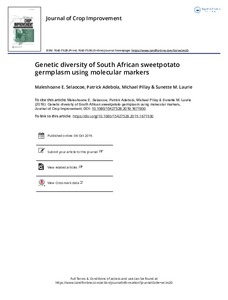| dc.contributor.author | Selaocoe, M.E. |
| dc.contributor.author | Adebola, P. |
| dc.contributor.author | Pillay, M. |
| dc.contributor.author | Laurie, S.M. |
| dc.date.accessioned | 2020-06-25T10:22:06Z |
| dc.date.available | 2020-06-25T10:22:06Z |
| dc.date.issued | 2019 |
| dc.identifier.citation | Selaocoe, M.E., Adebola, P., Pillay, M. & Laurie, S.M. (2019). Genetic diversity of South African sweetpotato germplasm using molecular markers. Journal of Crop Improvement, 1-20. |
| dc.identifier.issn | 1542-7528 |
| dc.identifier.uri | https://hdl.handle.net/20.500.12478/6872 |
| dc.description.abstract | Sweetpotato (Ipomoea batatas L.(LAM)) is one of the most important food crops in developing countries, including South Africa. Most sweetpotato varieties in South Africa are cream or white fleshed and lack the essential beta-carotene of the orange-fleshed varieties. To develop new varieties with high beta-carotene, knowledge of the genetic variation of the crop is needed. The objectives of this study were to assess the genetic relationships among 30 orange- and cream-fleshed sweetpotato accessions by (i) examining the variation in leaf proteins and (ii) using random amplified polymorphic DNA (RAPD). The polymorphism levels of the proteins and RAPD assays were 55.6% and 98%, respectively. The dendrograms generated from all the analyses clustered the accessions according to their flesh color and country of origin. Analysis of molecular variance (AMOVA) found a significant difference between the South African and non-South African germplasm. The high genetic diversity in the South African sweetpotato germplasm is a positive indicator for a breeding program that has a number of targets, such as breeding for nutritional improvement, disease resistance and drought tolerance. |
| dc.description.sponsorship | National Research Foundation |
| dc.format.extent | 1-20 |
| dc.language.iso | en |
| dc.subject | Proteins |
| dc.subject | Rapd |
| dc.subject | Sweet Potatoes |
| dc.subject | Genetic Markers |
| dc.subject | Germplasm |
| dc.subject | Genetic Variation |
| dc.title | Genetic diversity of South African sweetpotato germplasm using molecular markers |
| dc.type | Journal Article |
| cg.contributor.crp | Roots, Tubers and Bananas |
| cg.contributor.affiliation | Vaal University of Technology |
| cg.contributor.affiliation | International Institute of Tropical Agriculture |
| cg.contributor.affiliation | Agricultural Research Council-Vegetable and Ornamental Plants, Pretoria |
| cg.coverage.region | Africa |
| cg.coverage.region | Southern Africa |
| cg.coverage.country | South Africa |
| cg.coverage.hub | Southern Africa Hub |
| cg.identifier.bibtexciteid | SELAOCOE:2019 |
| cg.isijournal | ISI Journal |
| cg.authorship.types | CGIAR and developing country institute |
| cg.iitasubject | Agronomy |
| cg.iitasubject | Biodiversity |
| cg.iitasubject | Genetic Improvement |
| cg.iitasubject | Plant Genetic Resources |
| cg.journal | Journal of Crop Improvement |
| cg.notes | Published online: 06 Oct 2019 |
| cg.accessibilitystatus | Limited Access |
| cg.reviewstatus | Peer Review |
| cg.usagerightslicense | Copyrighted; all rights reserved |
| cg.targetaudience | Scientists |
| cg.identifier.doi | https://dx.doi.org/10.1080/15427528.2019.1671930 |
| cg.iitaauthor.identifier | Patrick Adebola: 0000-0002-5155-6194 |

